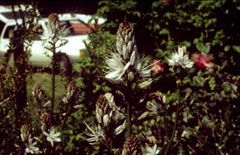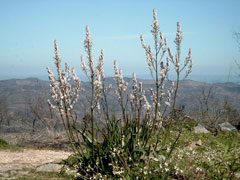 |
|
(c) 2010 Ken Fern & Plants For A Future |
 |
| http://commons.wikimedia.org/wiki/User:Lumbar |
Translate this page:
Summary
Physical Characteristics

 Asphodelus aestivus is an evergreen Perennial growing to 1 m (3ft 3in) by 0.3 m (1ft).
Asphodelus aestivus is an evergreen Perennial growing to 1 m (3ft 3in) by 0.3 m (1ft).
See above for USDA hardiness. It is hardy to UK zone 8 and is not frost tender. It is in leaf all year, in flower from June to August. The species is hermaphrodite (has both male and female organs).
Suitable for: light (sandy) and medium (loamy) soils, prefers well-drained soil and can grow in nutritionally poor soil. Suitable pH: mildly acid, neutral and basic (mildly alkaline) soils. It can grow in semi-shade (light woodland) or no shade. It prefers dry or moist soil and can tolerate drought.
UK Hardiness Map
US Hardiness Map
Synonyms
A. microcarpus. A. ramosus.
Plant Habitats
Woodland Garden Sunny Edge; Cultivated Beds;
Edible Uses
Edible Parts: Root Seed Stem
Edible Uses:
Tuber - cooked[4]. Rich in starch[89, 177]. Dried and boiled in water it yields a mucilaginous matter which can be mixed with grain to make a nutritious bread[4, 105]. Boiling destroys the acrid principle in the tubers[4], rendering them quite pleasant to eat[K]. Flowering stalk - cooked[89, 148]. Seed - roasted[89, 148].
References More on Edible Uses
Medicinal Uses
Plants For A Future can not take any responsibility for any adverse effects from the use of plants. Always seek advice from a professional before using a plant medicinally.
Acrid Antispasmodic Diuretic Emmenagogue
The root, gathered at the end of its first year, is acrid, antispasmodic, diuretic, emmenagogue[4]. It was used in the treatment of several diseases by the Greeks and Romans, but is not employed in modern medicine[4].
References More on Medicinal Uses
The Bookshop: Edible Plant Books
Our Latest books on Perennial Plants For Food Forests and Permaculture Gardens in paperback or digital formats.

Edible Tropical Plants
Food Forest Plants for Hotter Conditions: 250+ Plants For Tropical Food Forests & Permaculture Gardens.
More

Edible Temperate Plants
Plants for Your Food Forest: 500 Plants for Temperate Food Forests & Permaculture Gardens.
More

More Books
PFAF have eight books available in paperback and digital formats. Browse the shop for more information.
Shop Now
Other Uses
Adhesive Dye
The dried tuber is pulverized and mixed with cold water to make a strong glue[4] that is used by bookmakers and shoemakers[61, 89, 148]. A yellow dye is obtained from the tuber[46, 61].
Special Uses
References More on Other Uses
Cultivation details
Succeeds in ordinary garden soil, tolerating partial shade[200]. Requires a well-drained soil[1, 200]. Prefers a deep rich sandy loamy soil[1, 111]. Prefers a sunny position and a soil that is not too rich[200]. Grows well on hot dry banks[42]. This species is not hardy in the colder areas of the country, it tolerates temperatures down to between -5 and -10°c[200]. Plants are evergreen in mild winters[200]. Plants seem to be immune to the predations of rabbits[233]. This species is closely related to A. ramosus[187].
References Carbon Farming Information and Carbon Sequestration Information
Temperature Converter
Type a value in the Celsius field to convert the value to Fahrenheit:
Fahrenheit:
The PFAF Bookshop
Plants For A Future have a number of books available in paperback and digital form. Book titles include Edible Plants, Edible Perennials, Edible Trees,Edible Shrubs, Woodland Gardening, and Temperate Food Forest Plants. Our new book is Food Forest Plants For Hotter Conditions (Tropical and Sub-Tropical).
Shop Now
Plant Propagation
Seed - sow March/April in a greenhouse and only just cover the seed. Germination usually takes place in 1 - 3 months at 15°c[134]. When they are large enough to handle, prick the seedlings out into individual pots and grow them on in the greenhouse for at least their first winter. When the plants are large enough to handle, plant them out into their permanent positions in late spring or early summer. Division in early spring or autumn[111].
Other Names
If available other names are mentioned here
Native Range
TEMPERATE ASIA: Cyprus, Egypt (Sinai), Iraq, Israel, Jordan, Lebanon, Syria, Turkey EUROPE: Albania, Greece (incl. Crete), Italy (incl. Sardinia, Sicily), Spain (incl. Baleares), France (s. & Corsica), Portugal AFRICA: Spain (Canarias), Algeria (north), Egypt, Libya (north), Morocco
Weed Potential
Right plant wrong place. We are currently updating this section.
Please note that a plant may be invasive in one area but may not in your area so it's worth checking.
Conservation Status
IUCN Red List of Threatened Plants Status :

Growth: S = slow M = medium F = fast. Soil: L = light (sandy) M = medium H = heavy (clay). pH: A = acid N = neutral B = basic (alkaline). Shade: F = full shade S = semi-shade N = no shade. Moisture: D = dry M = Moist We = wet Wa = water.
Now available:
Food Forest Plants for Mediterranean Conditions
350+ Perennial Plants For Mediterranean and Drier Food Forests and Permaculture Gardens.
[Paperback and eBook]
This is the third in Plants For A Future's series of plant guides for food forests tailored to
specific climate zones. Following volumes on temperate and tropical ecosystems, this book focuses
on species suited to Mediterranean conditions—regions with hot, dry summers and cool, wet winters,
often facing the added challenge of climate change.
Read More
Expert comment
Author
Brot.
Botanical References
89200
Links / References
For a list of references used on this page please go here
Readers comment
© 2010, Plants For A Future. Plants For A Future is a charitable company limited by guarantee, registered in England and Wales. Charity No. 1057719, Company No. 3204567.